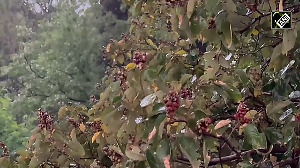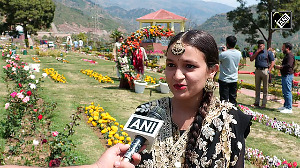
'The message from our ancient texts should reach the younger generation of Indians.'
'Our literature is in Sanskrit and scientists don't know the language. And the people who know Sanskrit, they don't know science.'
Dr Akhilesh Kumar Pandey, chairman, Madhya Pradesh Private University Regulatory Commission -- which regulates/monitors the standard of education in MP -- stirred a hornet's nest at the Indian Science Congress in Mysuru.
In his paper presented at the congress, DR Pandey said Lord Shiva sends out a strong message on the sustainability of the environment.
Dr Pandey, below, left, spoke to Syed Firdaus Ashraf/Rediff.com on his research paper on Lord Shiva and his concern for the environment.
On what basis have you said in your paper that Lord Shiva sends out a strong message of sustainability of environment?
It is based on our ancient literature like the Shiv Puran and the Ramayan. It is entirely based on that concept.
For instance, Lord Shiva stopped the flow of the Ganga. When King Bhagirath called Lord Shiva from earth, the flow of the Ganga river was so fast that in order to stop it, Lord Shiva took the river on his head and he allowed only that much water to flow from his hair that was needed for earth.
This is the concept of water conservation. This was the message. He emphasised that water must not be wasted.
Secondly, there was empowerment of women. He shows his respect to women because he kept her (the Ganga) on his head.
Today we talk of vibhuti (holy ash) and talk of nano technology. Lord Shiva used to smear bhasma (ash) from cremation material on his body. It is actually nano particles which people are analysing now. There is energy in it.
But...
Another thing you see is his family. He had a snake around his neck, the Nandi bull, and Goddess Durga used to ride the tiger; the rat was for Lord Ganesh, the peacock was for Lord Kartikeya.
You see, all these animals were against each other, but were together in one family and had coherence like a family.
It means in environment conservation, everyone is important to maintain the food chain.
The snake is important in its own way and the tiger is important in its own way. In short, Lord Shiva was preserving the environment. We need to learn from this. We also call Lord Shiva Neelkanth.
He took poison  in him and he has been compared to trees. It means we need to conserve plants to protect the environment.
in him and he has been compared to trees. It means we need to conserve plants to protect the environment.
Next, his dumroo -- its 52 sounds gave us 52 letters (beej mantras), of which 14 are good for society.
Another report said if you blow the shank (conch) you can cure spondylitis and thyroid problems, too.
I have no idea about that. I am a professor of botany. My aim is that the message from our ancient texts reach the younger generation of Indians. If this helps to improve the environment, I will be happy.
There are those who say you are departing from pure science and depending on legends.
Gandhari of the Mahabharat delivered 100 children. Today, it is being proved scientifically that it is possible.
I am talking of stem cell research and gene cloning. All these things were available somewhere in our ancient texts. All these things, if we validate, then it is possible that we will get some miracle.
Last year, a paper presented at the congress stated that the science of building and flying a plane was recorded by Maharishi Bharadwaj centuries before the Wright Brothers invented the aeroplane in America.
Rishi Bharadwaj's technology has described 23 different types of planes. Today, we talk of hydrogen fuel, but at that time there was technology on how to make hydrogen fuel available. It is possible that it is imagination.
However, we must validate it with Indian science and technology. All literature must be validated.
We talk of Sanjeevani booty (in the Ramayan). It is possible that there must be some Sanjeevani booty in our Himalayas.
Till the time we do not validiate, we cannot outright reject it.
Science so far has not agreed with what you are saying. It still considers all these things to be in the realm of belief and mythology. Do you agree with that?
You tell me. We did not follow our parampara (culture and traditions). In the name of development we cut so many trees. At the same time, in our tradition there are so many trees we do not cut like the peepal tree, mango tree and the tamarind tree.
Go to any village, people will not cut those trees. I request you just for some time believe that there are Gods living in those trees. Then in reality you find out how much oxygen the peepal tree generates. If we follow our parampara, then we will grow more peepal trees.
You are relating all these things to science.
If you read A P J Abdul Kalam's book Vision 2020, he says 'Dream, Dream, Dream.' Science is that only.
We don't know the result, but we need to dream.
If you don't imagine and not let your children imagine, you will not get results. They will not be innovative because they will not get thoughts and how will science develop?
Do you believe all these things were for real and there is nothing mythological about them?
Yes. The trouble is that our literature is in Sanskrit and scientists don't know the language. And the people who know Sanskrit, they don't know science.
The same is the case with Ayurveda. Can you deny Charaka Samhita? It is the bible of medicines in Ayurveda.
But Ayurveda is a different thing. What you are referring to is mythology.
You see, when thoughts come to you, then you go and research that. Even if you say that is a story, there is a scientific thought and approach to that. Isn't it?
Agastya Muni has written that copper makes electricity and he has described it.
In Sanskrit, a British scholar felt that Grivaha Sikha (like the neck of a peacock) meant that Agastya was saying electricity was made from the peacock's neck. But a Sanskrit scholar explained to him that what Agastya meant was that the electricity was made from a metal like that of the colour of the neck of the peacock (copper oxide is blue green).
I am only saying that whatever Agastya Muni said, we can validate it.











 © 2025
© 2025